
Dunburrowin, or the Rabbit Residence - Nikki White
A common question we get asked at shows, displays or when selling our bunnies, especially from those who have recently got the rabbit habit is what sort of house should their new friend have and what size. To answer this we must ask three further questions:
Let's assume we are talking about pet rabbits. The garden is a good place for a hutch The rabbit has fresh air and things to look at. If the hutch is movable he can cut your grass and fertilise it at the same time. The disadvantages are that he might be vulnerable to stray dogs and cats and is subject to the weather unless you cover him with a tarpaulin or move his hutch under cover. This is not always possible if it rains while you are away during the day. Also, in winter in particular, you can be staggering around in the dark and rain, clutching a torch in one hand and a feed bucket in the other which can be a bit of a drag when you have a lot to feed. Investing in a floodlight helps.
Indoors in a shed or garage avoids these problems but the bunny doesn't get as much fresh air or see as much unless the door is left open in which case stray animals can get in. A flyscreen door is a good idea if one can be attached as it not only keeps out stray animals but insects. So can the rain. Indoor cages require more cleaning as the bunny by-product doesn't go into the earth. The shed bunny should have an outside pen to exercise in when you are at home to supervise. Above all, if you house your rabbit in a garage the rule is: bunny in, car out, otherwise he will breathe in toxic fumes.
Most cages available in Canberra are for outdoors. The most common is a metal cage in three sizes. The largest is 125cm long x 66cm wide x 42 cm high; the medium is 105cm long x 50cm wide x 36cm high and the smallest is 87cm long x 36 cm wide x 39cm high. About a third is an enclosed sleeping area with a lid that opens and is fastened with a metal hook on top. There is also a slide at the top of the open area to permit feeding. I find it advisable to put a snap-hook on this slide to stop Thumper nosing his way out (and they do, believe me). These cages are easily cleaned and moved about. Their disadvantages are, being metal, they can be very cold in winter so need a lot of bedding; they have to be covered with mosquito wire to keep outside disease-carrying insects, which the rabbits love to chew up. Also I think they are not high enough for anything but dwarf breeds
Large metal hutch, side on.

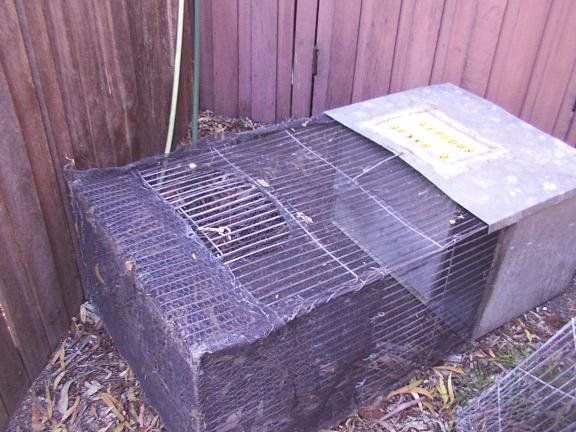
Large metal hutch top down. This is covered with flyscreen wire and a snap-lock has been aded to secure the top sliding door
Wooden cages used to be available for rabbits but were rather small. Those you see around now are probably for guinea-pigs as they are low and narrow.
If you don't like any of these, there are rabbit breeders and handymen who will make some for you. Or you can build one yourself.
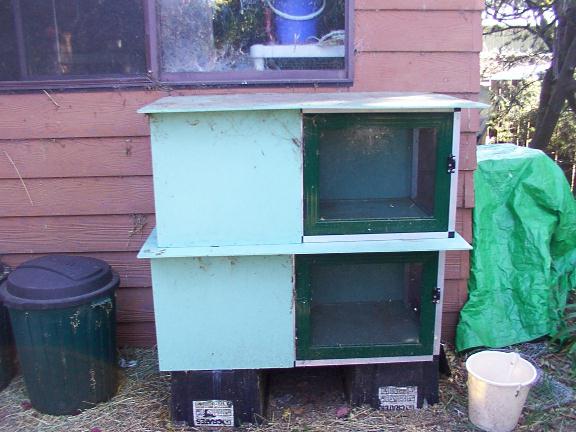
Note these have been places on upended plastic tool boxes so as not to be sitting on the ground. This makes them easier to reach, allows air to circulate underneath and keeps out damp
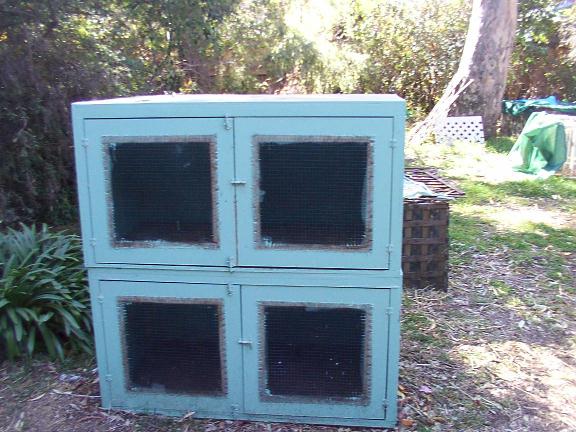 .
.
Another design, suitable for breeder cages as they are 120 cm long, 60cm high and 70 cm deep. Note they are covered
with flyscreen wire and painted with weather-proof acrylic outdoor paint.Most rabbit books have designs and dimensions or you can look around at other people's hutches. The most important things are that:
a) They are mosquito proof b) They are escape proof c) They must keep out other animals d) They must not be too small.
They should be at least 50cm high because bunnies like to stretch up on their back legs and you have to allow for their ears, too (less so with Lops). Some suggested minimum dimensions: for Dwarf breeds - 90cm long x 60cm wide; for medium breeds (Dutch, Rex, Satin, etc.) - 110-120cm long x 60cm wide; for large (California, New Zealand) - 150cm long x 60cm wide; giant breeds - 180cm long x 75cm wide x 75cm high. (Sources: Rabbit: a Practical guide to Caring for Your Rabbit by David Taylor, Rabbits by V. Haggerty; Rabbits by K & J Lawrence; New Rabbit Handbook by L. Vriends-Parent). They can be painted with a non-toxic paint (acrylic water-based, for example) to water-proof them and make cleaning easier. Mosquito wire (fly-screen wire) available by the metre from most hardware stores can be tacked over the wire on the door(s).
A cheap alternative for a couple of small rabbits or a medium sized one is to convert a baby's wooden play-pen. Cover the bottom with chicken wire or aviary wire. Attach aviary wire to the posts around the outside and tack mosquito wire over that. Inside put a plastic box with a lid and a hole cut for the rabbit to come in and out. Inside this put newspaper and straw for a bed. The rabbit will enjoy jumping on and off the box and roosting on its lid. A piece of lattice, lined with wire (to prevent chewing) with mosquito mesh or shade-cloth tacked on to it can serve as a "lid" for the pen. This pen can be moved around the yard easily so the bunny can get fresh grass. A bird's hanging plastic food bowl can be attached to the aviary wire for food or water. Or you can fit a gravity water bottle with a harness made from tie-wire and hang it from the inside on the aviary wire, so as not to compromise the mosquito wire with a hole.
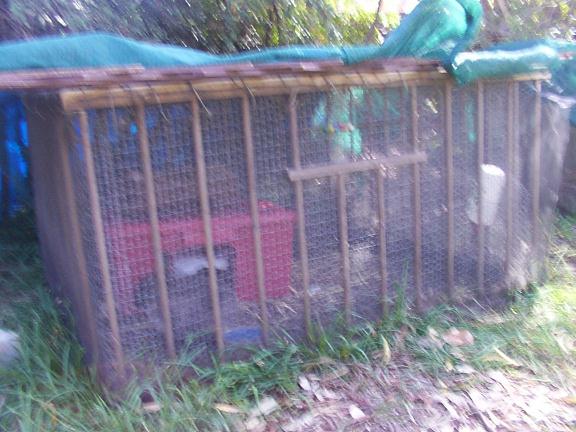
Converted child's playpen. It has aviary wire attached between the wooden struts and flyscreen wire around it. Inside can be seen a plastic box with a hole cut in it for the bunny to sleep, gravity bottle and ceramic crock.
Similarly, you can make a cage or outdoors exercise pen for an indoor bunny by lashing garden lattice together (two sides of 180cm with two sizes of 120 cm), covering it with mosquito wire and putting an expanding lattice on the top to permit easy access and covering that with shade cloth not only to keep out insects but to protect the bunny from the sun.
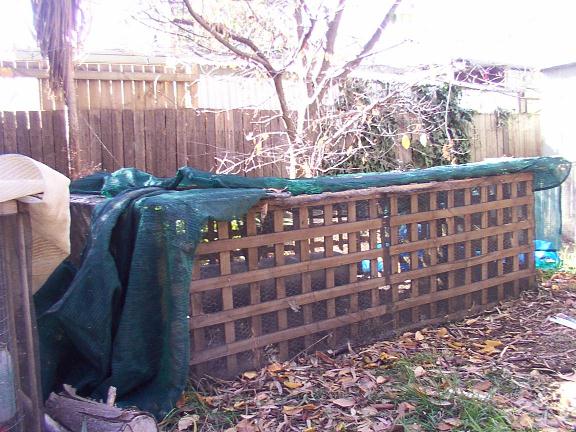
Pen made from garden lattice with shade cloth on top, aviary wire lining it and mosquito netting on the outside. Inside can be seen a metal pipe for the bunny to play in.
A gravity bottle for water is a good thing outside because the rabbit cannot kick dirt into the water and water is always available as they cannot up end it. They should be attached in such a way as not to make a hole in the protective fly-screen. With indoor cages, their disadvantage is that they often leak and make things wet. Heavy ceramic crocks are good, especially if the rabbit is running on carpet and less likely to kick rubbish into them. They are heavy enough not to be easily upended (though a couple of my does - who must have been waitresses in a previous existence - like to stack them all up neatly in a pile).
Suppose you've decided to take the next step and want to start breeding your own rabbits. You will need banks of cages. These can be located either in the garden or set up in a shed or garage (again, bunny in, car out). Rabbitry cages come in two basic types - box-like or oblong. The former are usually between 60cm x 60cm x 60cm and 80cm x 80cm x80cm. The latter are usually 110-120cm x 50-60cm x 50-60cm and often include a built-in nest-box. They also often can be sub-divided by a sliding panel to separate mother from kits, or to make two smaller cages for baby rabbits. This design is good for breeder cages.

Bank of cages in rabbitry. They all have flyscreen wire over the doors and most have gravity bottles attached.
The best thing to do is to talk to as many rabbit breeders as you can and look at their arrangements. Ask them the advantages or disadvantages and why they chose the design they did or if they would do it differently. You will need to consider the size of the breeds you intend to specialise in; ease of cleaning (having a door or doors that open up the whole front, for example); whether you want separate breeder cages or to make your normal ones easily converted into them; what you are going to run your rabbits on (litter pan on lino and carpet; litter pan on wood-shavings or rice bran; no litter-pan but shavings, chaff, bran, hay or straw or combination of these, etc.); where and how you are going to store dry food (pellets, mix, etc.) and cleaning and other equipment; nest-boxes (if not built-in). Litter pans should ideally have a sturdy wire inset so the bunny can sit out of the way of his business. If you decide to use cat litter in the tray (I think it makes cleaning easier), avoid clumping litters like the plague. They can be fatal, as a breeder of Siamese cats discovered. Those made out of recycled newspaper are good an absorb moisture and odours well. You have to decide how many cages. You can never have too many but you do have to balance this against how much time you can spend in cleaning them as this has to be done once a week. You will have to decide where they are to go bearing in mind the advantages and disadvantages of both indoors and outdoors.
The cages will have to be custom built, either by you or by someone else (carpenter, other rabbit breeder). A cheap alternative for small rabbits and when you are just starting out is a converted wardrobe.
In summary, whether located in a shed or in the garden, Loppy Acres should be roomy, easy to clean, mosquito-proof, predator-proof and escape-proof. Commercial metal cages are readily available but custom built ones are also available from some rabbit breeders or you can build your own, bearing in mind the above. Best of all is to look at other people's rabbit domiciles and ask them why they chose to go that way. Then take the best for your new charge(s).
Indoors
Rabbits may also be kept indoors. They can either be house bunnies, that is given the run of the house like a cat, or they can simply live inside at night and go outside to an exercise pen by day. If they are to live inside permanently, they will still need a cage as somewhere they can feel safe and where they can sleep. They can be litter-trained (basically you put the tray where they do their business as they tend to go in the same place). You will also need to secure all electrical wires, either by moving them out of the rabbit's reach, covering them with a sheath you can get from the hardware store or by coating them with tabasco or chilli sauce. Bunnies like to chew wires. There are a number of good books on house rabbits, such as Hop To It by Samantha Hunter (Barrons, 1991 ISBN 08120 45513) or House Rabbit Handbook by Marinell Harriman (Drollery Press, 1995, 3rd ed.). There is also the House Rabbit Society website.
There are a number of indoor cages in various sizes which can be bought from pet shops. The smallest suitable for a rabbit is the 70 cm long x 40 cm deep x 38 cm one. This is for one small rabbit only. Better is the 98 cm x 50 cm deep x 47 cm high or the largest which is 117 cm long x 55 cm deep x 51 cm high and can accommodate a couple of rabbits. Yokozuna, my British Giant buck sleeps in a 98cm x 50 cm x 47 cage (which sits on the coffee table in the lounge room) but goes out to a 180cm x 120 cm x 90 cm pen by day.
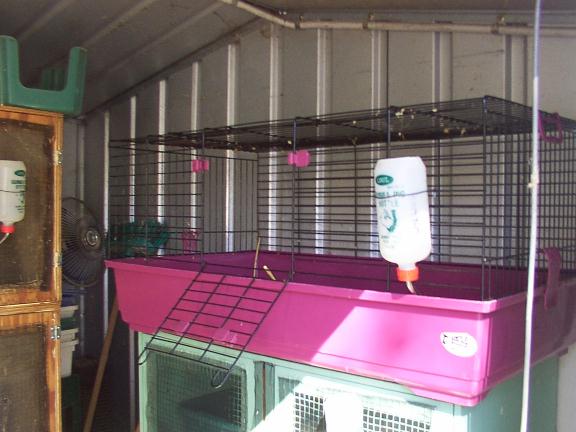
This is the 98 cm x 50 cm deep x 47 cm sized cage. This one is on top of some cages in the rabbitry and shows how the front door drops down to form a ramp if you had the cage on the floor. A Cashmere Lop lives in this one and spends his days outside in the big cat enclosure with the cats.
These have plastic bases and wire tops. There is a door in the front and one in the top (I use the top door for Yokozuna as he is too big to be lifted comfortably through the front door. The wire tops snap off so they are easily cleaned. All you have to do is take out the soiled litter and blast them out with a hose, and dry them. Urine crystals can be removed with cleaning (white) vinegar. I put wood shavings or sawdust plus meadow hay, pea straw, or ordinary straw. Oaten straw is good if it is available, which it usually isn't. These cages usually come with a gravity bottle for water and you need to buy a heavy ceramic crock for food. A ceramic dog bowl is good for larger rabbits, smaller ones like Netherland Dwarfs, Dutch, Mini and Dwarf Lops can have ceramic cat bowls. The cage can be put on a low table or a stand unless it is for a house bunny where the floor is better to allow the rabbit to come and go through the front door of the cage which drops down like a ramp.